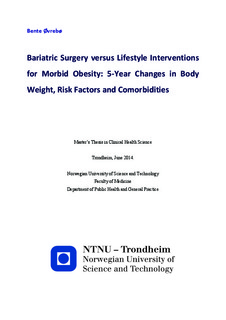Bariatric Surgery versus Lifestyle Interventions for Morbid Obesity: 5-Year Changes in Body Weight, Risk Factors and Comorbidities
Master thesis
Permanent lenke
http://hdl.handle.net/11250/281450Utgivelsesdato
2014Metadata
Vis full innførselSamlinger
Sammendrag
Background: Not all morbidly obese patients want, or are eligible for bariatric surgery, and
therefore depend on effective lifestyle interventions. Purpose: This study aimed to compare
changes in body weight (BW), risk factors and comorbidities 5 years after Roux-en-Y gastric
bypass (RYGB) or three lifestyle interventions in morbidly obese patients. Methods: 209
(75.1% women) morbidly obese adult (mean (standard deviation (SD)): age 40.9 years (9.5),
BW 133.4 kg (19.6), body mass index (BMI) of 45.4 kg/m
2
(5.6)) patients were non-randomly
allocated to: A) laparoscopic RYGB (n = 58), B) weight loss (WL) camp (n = 30), C)
residential intermittent program (n = 64), or D) hospital outpatient program (n = 57). BW, risk
factors and comorbidities were assessed at baseline, 1 and 5 years. Results: 89.0% and 54.1%
completed the 1- and 5-year follow-up, respectively. Analysis of 5-year completers yielded a
general reduction in BW at year 1 (-25.9 kg, 95% CI [-30.3, -21.6], p<0.001), followed by a
regain of 11.3 kg (95% CI [6.9, 15.6], p<0.001) from 1 to 5 years. An overall reduction in
BW from baseline was observed at the 5-year follow-up (-14.7 kg, 95% CI [-19.1, -10.3],
p<0.001). After 5 years the RYGB group had lost significantly more BW (-30.9kg, 95% CI [-35.9, -25.9]), compared to the lifestyle groups: B (-13.3kg, 95% CI [-24.5, -2.1]), C (-5.5kg,
95% CI [-10.8, -0.2]) and D (-4.1 kg, 95% CI [-10.0, 1.8]) (all p<0.001), with no significant
differences observed between the three latter groups. RYGB, group B, and group C had
significant within-group WL after 5 years (all p<0.05). Plasma glucose and high-density
lipoprotein cholesterol (HDL) were significantly better in the RYGB group at 5 years
compared with all lifestyle groups (all p<0.05). Furthermore, a higher proportion of patients
in the RYGB group experienced remission of hypertension compared with the lifestyle groups
merged into one group (p<0.05). Conclusion: At the 5-year follow-up the RYGB was
associated with a greater WL, overall healthier glucose and blood lipids, and a larger
remission of hypertension, compared with lifestyle interventions. However, a significant 5-year WL was observed with lifestyle interventions as well.
